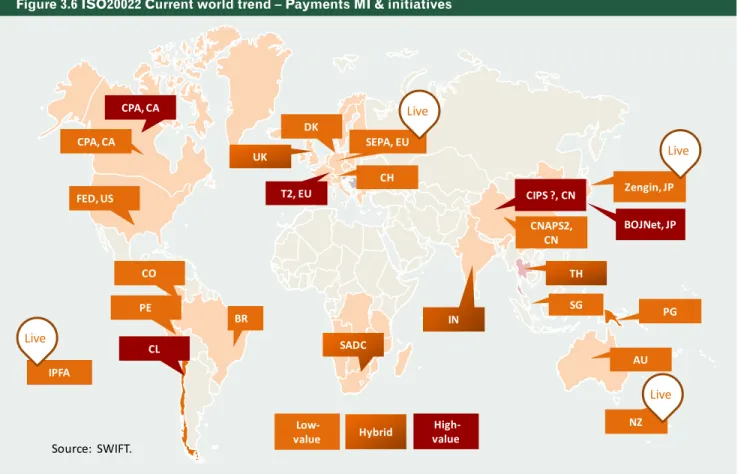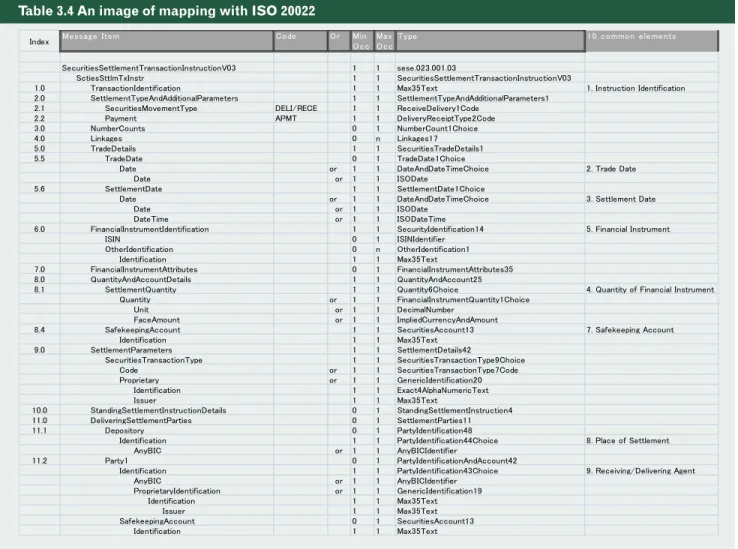ASEAN+3 Bond Market Forum
Sub-Forum 2 (ABMF SF2)
A S E A N +3 Information on Transaction
Flows and Settlement
Infrastructures
Information on
Transaction Flows
and Settlement
Infrastructures
ASEAN+3 Bond Market Forum
Sub-Forum 2 (ABMF SF2)
December 2013
ASEAN+3
ISBN 978-92-9254-448-5 (Print), 978-92-9254-449-2 (PDF) Publication Stock No. RPT146359-3
Cataloging-In-Publication Data Asian Development Bank.
ASEAN+3: Information on Transaction Flows and Settlement Infrastructures ASEAN+3 Bond Market Forum: Sub-Forum 2 (ABMF SF2)
Mandaluyong City, Philippines: Asian Development Bank, 2014.
1. Regionalism 2. Subregional cooperation 3. Economic development 4. Asia I. Asian Development Bank.
The views expressed in this publication are those of the authors and do not necessarily reflect the views and policies of the Asian Development Bank (ADB) or its Board of Governors or the governments they represent.
ADB does not guarantee the accuracy of the data included in this publication and accepts no responsibility for any consequence of their use.
By making any designation of or reference to a particular territory or geographic area, or by using the term “country” in this document, ADB does not intend to make any judgments as to the legal or other status of any territory or area.
ADB encourages printing or copying information exclusively for personal and noncommercial use with proper acknowledgment of ADB. Users are restricted from reselling, redistributing, or creating derivative works for commercial purposes without the express, written consent of ADB.
Note:
In this publication, “$” refers to US dollars. Asian Development Bank
6 ADB Avenue, Mandaluyong City 1550 Metro Manila, Philippines Tel +63 2 632 4444
Fax +63 2 636 2444 www.adb.org
For orders, please contact: Department of External Relations Fax +63 2 636 2648
adbpub@adb.org
This report is the outcome of a regional technical assistance project, RETA 8049:Harmonization of Bond Standards and Market Practices in ASEAN+3: Support for ASEAN+3 Bond Market Forum, Phase 2 under the Asian Bond Markets Initiative.The project was managed by Seung Jae Lee, Advisor and Shinji Kawai, Senior Financial Sector Specialist of the Office of Regional Economic Integration. The co-authors of the report are Shinji Kawai and ADB Consultant Dr. Taiji Inui, together with ABMF members and experts.
Statement from
SF2 Chairs
The Chair and Vice-Chairs express their heartfelt gratitude to members and experts of ABMF SF2 for their contributions in making this initiative fruitful. The Chair and Vice-Chairs hope to enjoy the continuous support of the members and experts since this Report is only the first stage of bringing
the objectives of ABMF to fruition. The Chair and Vice-Chairs also express their heartfelt gratitude to the ADB Secretariat Team, in particular the ADB Consultant for ABMF SF2 and his team, for drafting this Report.
Mr. Jong-Hyung Lee Ms. Margeret Mutiara Tang Mr. Yuji Sato
Chair of ABMF SF2 Vice-Chair of ABMF SF2 Vice-Chair of ABMF SF2
Preface
T
here have been significant developments in bond markets in Asia since the early 2000s. The amount of local currency (LCY) bonds outstanding in emerging East Asia has grown sharply from less than US$1.0 trillion at the end of 2001 to US $6.5 trillion at the end of 2012.a LCY bond markets became an effective alternative source of financing for governments and corporations during the recent global financial crisis, and are characterized by increasingly diversified issuance and a broader investor base that includes non-residents. The regional channeling of regional resources to regional investment needs improved from 2.8% in 2001 to 8.4% in 2011, as measured by the relative share of the region’s debt portfolio outflows being re-invested within the region.However, there still remain various issues to be addressed. For example, the region’s bond market is still small in size due to the continued dominance of the banking sector, regional resource channeling needs to be further enhanced, volatile capital flows must be appropriately managed, and there is a need to improve market efficiency through lower transaction costs by implementing cross-border, straight-through-processing (STP) by harmonizing and standardizing message flows and items, and by streamlining regulations and market practices.
For a more efficient discussion on implementing cross-border STP and streamlining regulations and market practices, the ASEAN+3 Bond Market Forum (ABMF) was established in 2010—and
a Emerging East Asia comprises the 10 members of ASEAN plus the People’s Republic of China, Japan, and the Republic of Korea.
endorsed by the ASEAN+3 Finance Ministers at the 13th ASEAN+3 Finance Ministers’ Meeting on 2 May 2010 in Tashkent, Uzbekistan—as a common platform to foster standardization of market practices and harmonization of regulations relating to cross-border bond transactions in the region.
The members of ABMF appointed or endorsed by the Asian Bond Markets Initiative (ABMI) Task Force 3 (TF3) include regulatory bodies, stock exchanges, depositories, self-regulatory organizations (SROs), market associations, and international market institutions. The Asian Development Bank (ADB) serves as the Secretariat. ABMF is expected to contribute to bond market development by offering a regional platform to enhance standardization and incorporating both public and private entities. Since the first meeting in September 2010 in Tokyo, Japan, ABMF members and experts have met quarterly in December 2010 in Manila, Philippines; February 2011 in Kuala Lumpur, Malaysia; June 2011 on Jeju Island, Republic of Korea; September 2011 in Bali, Indonesia; December 2011 in Beijing, People’s Republic of China; February 2012 in Hong Kong, China; April 2012 in Manila, Philippines; September 2012 in Seoul, Republic of Korea; November 2012 in Bangkok, Thailand; February 2013 in Singapore; April 2013 in Jakarta, Indonesia; July 2013 in Tokyo, Japan; and November 2013 on Jeju Island, Republic of Korea. Fourteen meetings have been held in total.
ABMF consists of two forums: Sub-Forum 1 (SF1) and Sub-Forum 2 (SF2). The objective of SF1 is to
close the information gap in regulations, market practices, and other areas in the region’s bond markets. SF2 focuses on enhancing regional STP through the harmonization of transaction procedures and standardization of messages. In its first phase of activity during 2010–11 (Phase1), SF1 worked on collecting legal and regulatory information for the individual ASEAN+3 markets, and SF2 identified detailed information on bond transaction flows.
As a key output of ABMF Phase1 activities, a comprehensive ASEAN+3 Bond Market Guide (the Guide) was published in April 2012, including individual bond market guides for ASEAN+3 member economies. The Guide consisted of Volume 1: Sub-Forum 1—Comparative Analysis and Bond Market Guides, and Volume 2: Sub- Forum 2—Information on Transaction Flows and Settlement. The Guide aimed to dispel persistent misperceptions about ASEAN+3 markets. The Guide was expected to narrow information gaps and establish a common understanding of how markets in the region operate.
The information and findings gathered during Phase1 became the foundation of the next phase of activities during 2012–13 (Phase2). In Phase2, SF1 has been working on developing a regionally standardized bond issuance framework called the ASEAN+3 Multi-Currency Bond Issuance Framework (AMBIF), and SF2 on enhancing survey practices to identify information about government and corporate bond transaction flows and delivery-versus-payment (DVP) flows, and interest payments and redemption procedures. Based on the survey results, SF2 provided policy recommendations to implement cross-border STP through the harmonization and standardization of transaction flows and message items. With continued discussions and consultations, ABMF members finalized the interim reports for both SF1 and SF2 during the 12th ABMF Meeting on 23–24 April 2013 in Jakarta, Indonesia, describing key policy recommendations for AMBIF on standardizing bond transaction flows and message items. The interim reports were submitted to the ASEAN+3 Finance Ministers’ and Central Bank Governors’ Meeting (AFMCGM) on 2 May 2013 through ABMI TF3.
This report, entitled ASEAN+3 Information on Transaction Flows and Settlement Infrastructure
and consisting of three parts, is the result of Phase2 studies of ABMF SF2 and enhances the findings of Phase 1. Part 1 provides an overview of ASEAN+3 bond markets and their infrastructure. Part 2 reports on the bond market- related issues of economies in the region. Part 3 contains diagrams of ASEAN+3 bond market infrastructures, domestic bond transaction flows, and cross-border bond transaction flows. The contents of the report are as follows.
Overview
Part 1: Bond Markets and Their Infrastructures in ASEAN+3
Part 2: Bond Markets and Their Infrastructures in Individual Economies
Part 3: Bond Market Infrastructure Diagrams, Domestic Bond Transaction Flows, and Cross-Border Bond Transaction Flows This report was completed through the joint efforts of national members and experts, and international experts participating in ABMF SF2, supported by the ADB Secretariat comprising Shinji Kawai of ADB’s Office of Regional Economic Integration (ADB OREI), Seung Jae Lee (ADB OREI), and Taiji Inui (ADB Consultant).
Thanks also go to ABMF SF2 Chair, Jong-Hyung Lee (Korea Securities Depository) and the Vice- Chairs, Margaret Mutiara Tang (Indonesian Central Depository) and Yuji Sato (Japan Securities Depository Center), for their leadership in facilitating active discussions and guiding SF2 members and the ADB Secretariat.
The national members and experts kindly provided inputs by answering questionnaires and commenting on diagrams during market visits and the draft review process.
The international experts very kindly provided report inputs and freely shared their requirements and assessments, often from proprietary sources. In addition, the team thanks all interviewees who gave useful comments and responses during the Phase2 market visits. Therefore, the report should be regarded as a crystallization of region-wide collaborative efforts and knowledge sharing toward more harmonized and integrated ASEAN+3 bond markets.
Without such strong support and cooperation from ABMF members and experts, as well as from market experts in the region, this report could not have been published.
The team also thanks the national members and experts of Hong Kong, China; Indonesia; Japan; the Republic of Korea; the Philippines; Singapore; and Thailand for hosting ABMF meetings in Phase2. The smooth organization of the meetings made possible the conduct of intensive discussions in multiple sessions at each meeting. In addition, valuable advice, support, and guidance were provided by ABMF Japan members, in particular by the Ministry of Finance. Also, supporting teams at ADB and the NTT DATA Corporation helped the ADB Consultant for SF2.
The bond markets and infrastructures in the region are rapidly developing by adopting international standards and principles. However, the efforts toward harmonization and standardization of ASEAN+3 bond markets have just begun. Given large differences in the levels of economic and bond
market development in the region, the task will not be easy. The related work is inevitably gradual and step-by-step. The further harmonization and standardization of cross-border STP for bond transactions in the region will be a major challenge. There are no obvious low-hanging fruits in such an endeavor. As such, SF2 will continue to foster a region-wide understanding of the benefits of more harmonized and standardized bond transactions. This unique initiative will create momentum to push the region toward deeper, more liquid, and more integrated bond markets.
ABMF is expected to continue to function as a platform to realize and institutionalize regionalism by helping formulate regional views and opinions into a common policy framework.
Finally, it should be noted that no part of the report represents the official views of any of the institutions that participated as ABMF members or provided experts. The ADB team is responsible for the contents of the report.
ABMF Secretariat Team
Bond Markets and
Their Infrastructures
in ASEAN+3
Part 1
Contents
Executive Summary ... 5
Introduction ... 8
Purpose of ASEAN +3 Bond Market Forum ... 8
Organizational Structure and Governance ... 9
Purpose and Position of ABMF Sub-Forum2 ... 9
Settlement Barriers Based on the Survey on the GoE Report ... 10
Outline of Phase1 Studies by ABMF SF2 ... 12
Schedule of Sub-Forum 2 during Phase 2 ... 13
Methodology and Approach of the Survey ... 15
Possible Goals of SF2 ... 15
Methodology Overview ... 17
Survey Questionnaire ... 20
Fit and Gap Analysis ... 20
Background on Fit and Gap Analysis of Bond Transactions ... 20
Scope of Fit and Gap Analysis ... 21
Findings on Bond Market Infrastructures and Transaction Flows ... 23
Introduction ... 23
Bond Market Infrastructures ... 23
DVP Flows ... 27
Interest Payment Flows ... 29
Message Standards ... 29
Message Formats ... 29
Message Items ... 30
Numbering and Coding... 32
International Securities Identification Number (ISIN) ... 32
Business Identifier Code (BIC) ... 33
Securities Account ... 34
Character Code Set and Language ... 35
Market Practices and Others ... 39
Settlement Cycles ... 39
Operating Hours ... 43
Matching Types ... 43
Reporting Rules ... 43
Physical Certificates ... 44
Cross-Border DVP Flows and LCY Liquidity ... 45
Communications Protocol ... 46
Key Observations and Policy Recommendations ... 48
Bond Market Infrastructure ... 48
DVP Flows ... 49
Interest Payment Flows ... 49
Message Standards including Numbering and Coding ... 50
Market Practices and Other Issues ... 51
Cross-Border STP and LCY Liquidity ... 51
Knowledge Support... 53
Next Phase of ABMF SF2 Activities and Roadmap ... 55
Overview ... 55
Harmonizing Message Flows ... 56
Concept of Harmonizing DVP Flows ... 56
Initial Candidates of Reference Model DVP Flows ... 57
Scope of Harmonizing Message Flows ... 60
Standardizing Message Items for ISO 20022 Migrations ... 60
ISIN ... 60
Harmonization of Market Practices ... 61
Study on Cross-Border Collateral and Repo Services ... 62
Roadmap and Future Work Plan ... 62
Conclusion ... 64
Appendixes
1 Members and Experts including Observers and ADB Secretariat ... 66
2 Trade Matching and Settlement Matching ... 69
3 References... 71
4 Information Sessions of ABMF SF2 ... 72
5 Respondent Institutions During Sub-Forum2 Country Visits ... 74
6 Abbreviations ... 76
Executive
Summary
T
he ASEAN+3 Bond Market Forum (ABMF) was established in September 2010 after being endorsed by the ASEAN+3 Finance Ministers’ Meeting as a common platform to foster the standardization of market practices and harmonization of regulations relating to cross-border bond transactions in the region.1 ABMF aims to discuss various bond market issues in order to enhance the mobilization of regional savings for regional investments, and to improve information flow in regional markets. ABMF consists of two forums: Sub-Forum 1 (SF1) and Sub-Forum 2 (SF2). The objective of SF1 is to close the information gap in regulations, market practices, and other areas in the region’s bond markets.2 SF2 focuses on enhancing regional straight-through-processing (STP) through the harmonization of transaction procedures and standardization of messages. ABMF SF2 members and experts discussed how to enhance regional STP of bond transactions from trade to settlement. ABMF SF2 conducted a survey of delivery-versus-payment (DVP) flows and interest payment and redemption flows for both government and corporate bonds.1 Currently, ASEAN+3 Finance Ministers and Central Bank Governors’ Meeting.
2 SF1 is presently focusing on the ASEAN+3 Multi-Currency Bond Issuance Framework (AMBIF).
Survey findings on (i) bond market infrastructure, (ii) DVP flows, (iii) interest payment flows, (iv) message standards, (v) numbering and coding, (vi) market practices and other issues, and (vii) cross-border DVP flows are summarized in this report. Fit and gap analyses of DVP flows and interest payment flows were conducted to identify similarities and differences with an eye toward future harmonization in the region. Message format, numbering and coding, and market practices are also discussed with respect to standardization and harmonization. Some characteristics of cross-border DVP flows, such as additional messages to meet FX and cash controls in each economy, are also identified based on the survey results.
Observations and Policy
Recommendations
Based on our findings, the following observations and policy recommendations aimed at fulfilling the objectives of ABMF SF2 were compiled: (i) Bond market infrastructure. Robust and
sound bond market infrastructure such as Central Securities Depository (CSD) and Real Time Gross Settlement (RTGS) systems have already been implemented
in the 10 economies that have developed bond markets in the region.3 However, infrastructure to promote further efficiency and risk reduction purposes—such as Pre- Settlement Matching System (PSMS), Central Counterparty (CCP), Trade Repository (TR), and automated Trading System (TS)— have not yet been implemented in most economies. Such infrastructure may be introduced eventually depending upon a variety of market conditions, including trade values, trade volumes, and the number of market participants.
(ii) DVP flows. Bond trade and settlement (DVP) flows in ASEAN+3 vary across different economies and CSDs. The flows for residents are in some cases different from those for non-residents. It is recommended that in discussing harmonizing trade and settlement flows the impact on both infrastructure and the connected participant systems be considered. Such harmonization could be utilized for defining the requirements of interlinking gateways and/or establishing a hub between CSD and/or RTGS systems in the region.
(iii) Interest payment flows. Interest payments and redemption flows also vary across different economies and CSDs. One of key reasons for the different flows lies in the different tax regimes applied. Regarding interest payment flows, it will be difficult to simply standardize them into a single flow since there are so many fundamental differences owing to different tax regimes (e.g., capturing the tax status of investors, legal interpretation of tax withholding agent). In our survey, many market participants expected regulators to be able to exempt non-residents from withholding tax (WHT). (iv) Message formats, including numbering and
coding. Message formats in most economies in ASEAN+3 are not yet compliant with international standards. It is recommended that the message format in all markets be made compliant with ISO 20022, and ABMF
3 The 10 economies comprise the People’s Republic of China (the PRC); Hong Kong, China (Hong Kong, China); Republic of Indonesia (Indonesia); Japan (Japan); Republic of Korea (the Republic of Korea); Malaysia (Malaysia); the Philippines (the Philippines); Singapore (Singapore); (Thailand); and Viet Nam (Viet Nam).
members and ASEAN+3 authorities are expected to support the migration of message standards of bond market infrastructure to ISO 20022. The numbering and coding standards already registered as international standards—such as International Securities Identification Number (ISIN) and Business Identifier Code (BIC)—are recommended to be adopted in ASEAN+3.
(v) Market practices. It is recommended that market practices be harmonized across ASEAN+3, which could lead to the smoother processing of cross-border trade and settlement. Also, it could increase the possibility for cross-border collateral, repurchases (repo), and DVP to be used more flexibly in the region. The harmonization of market practices might be discussed where possible considering the costs and benefits of implementation in ASEAN+3.
(vi) Cross-Border STP and LCY liquidity. FX and cash controls are perceived as one of the key barriers to executing cross-border trade and settlement. During the ABMF SF2 survey, many market participants addressed the need for deregulation of such controls to promote cross-border trade and settlement, and the improved availability of local currency (LCY). On the other hand, with changing regulatory demands and collateral landscapes in recent years, demand for cross-border collateral and cross-border repo services has been increasing worldwide, including in ASEAN+3. Under such circumstances, it is recommended that ABMF SF2 further study cross-border collateral and repo from a technological perspective, including current market practices, regulatory aspects, and infrastructures. The study could also include linking CSDs in ASEAN+3 with the intent of utilizing central bank money.
Suggestions for the Next
Phase of ABMF Activities
Considering the above observations and policy recommendations, the following are suggested topics for ABMF SF2 to tackle in its next phase. (i) Harmonization of message flows. Discuss
best practices of message flows to identify commonalities and differences, including underlying requirements for critical messages, and propose reference models of message flows where practical.
(ii) Standardization of messages—migration to international standard. Adopt ISO 20022 and ISIN as an ASEAN+3 standard to promote cross-border trade and settlement. (iii) Harmonization of market practices.
Formulate a plan for the harmonization of market practices wherever it would be effective and possible.
● Specific market practices to be discussed will be chosen from the viewpoint of promoting cross-border STP in ASEAN+3 and considering the costs and benefits of standardization.
● Settlement cycles in line with foreign exchange (FX) spot dates and the time period between the record date and payment date could be candidates to be studied.
(iv) Study on cross-border collateral and repo services. Study current market practices, related legal and regulatory aspects, and infrastructures with the goal of identifying best practices and providing policy recommendations for the benefit of further development in cross-border collateral and repo markets.
● The study could include cross-border collateral and repo services linking CSD and RTGS systems.
● Interest payment flows related to cross- border collateral and repo services linking CSD and RTGS systems could also be studied.
Roadmap and Work Plan. In relation to the suggested next phase of ABMF activities, ABMF SF2 would like to propose the following Roadmap and Work Plan, subject to approval by Asian Bond Markets Initiative (ABMI) Task Force 3 (TF3) members.
(i) Phase 3 activities (2014–15). Provide proposals for the harmonization of ASEAN+3 bond markets, including a
● proposal on a reference model of DVP flows,
● proposal on ISO 20022 adoption of message items,
● proposal on harmonizing market practices wherever possible, and
● proposal on cross-border collateral and repo services.
(ii) Medium- to long-term (after 2015). Implement international standards by
● upgrading or redesigning bond market infrastructure in accordance with international standards (e.g., ISO 20022) in some economies,
● progressing in harmonizing market practices such as the settlement cycle,
● progressing in discussing linkages among and the region’s bond market infrastructures. Submission of the report to ABMI TF3. ABMF SF2 would like to submit this Phase 2 report to ABMI TF3 as the key findings of SF2. SF2 members expect that the information and data accumulated through ABMF SF2 activities will be utilized as substantial and practical references in pursuing the harmonization of transaction flows and market practices. ABMF SF2 members hope the suggested recommendations in this report can serve as a reference for authorities in the design and implementation of bond market policies.
A list of members and experts, including observers and the ADB Secretariat Team, is presented in Appendix 1.
Introduction
Purpose of ASEAN+3
Bond Market Forum
T
he ASEAN+3 Bond Market Forum (ABMF) was established in September 2010, based on the endorsement of the ASEAN+3 Finance Ministers’ Meeting, as a common platform to foster the standardization of market practices and harmonization of regulations relating to cross- border bond transactions in the region.1ABMF is expected to discuss various bond market issues to further develop liquid and well-functioning bond markets in order to make cross-border bond investment and settlement
1 The Joint Ministerial Statement of the 13th ASEAN+3 Finance Minis- ters’ Meeting on 2 May 2010 in Tashkent, Uzbekistan states: “We [ASE- AN+3 Finance Ministers] took note of the Group of Experts’ findings and suggestions on facilitating cross-border bond transactions and settlement, and welcomed the establishment of the technical work- ing group on Regional Settlement Intermediary (RSI) to further evalu- ate the policy recommendations. We endorsed the establishment of ASEAN+3 Bond Market Forum (ABMF) as a common platform to foster standardization of market practices and harmonization of regulations relating to cross-border bond transactions in the region.”
both smoother and less expensive; hence, the region’s abundant savings can be channeled more effectively to meet the region’s increasing investment needs.
ABMF aims to (i) assess existing regulatory frameworks and identify recommendations on how to foster the harmonization of regulations and market practices to facilitate cross-border bond transactions in the region, (ii) enhance dialogue between the private sector and ASEAN+3 officials to develop bond markets in the region and promote harmonization, standardization, and integration; and (iii) provide opportunities to exchange knowledge, expertise, and experience between the region’s private and public sectors. ABMF also took stock of the Group of Experts (GoE) report2 on Cross-Border Bond Transactions and Settlement Issues.
2 ASEAN+3 ABMI Task Force 4–Groups of Experts. http://asean3goe. adb.org
Promoting Issuance of Local Currency- Denominated Bonds -Credit Guarantee and Investment Facility (CGIF)
-Promotion of Asian Currency Note Programme
-Promoting issuance of structured finance instruments
Facilitating Demand for Local Currency- Denominated Bonds -Development of investment environment for institutional investors -Information dissemination through AsianBondsOnline
Improving Regulatory Framework
-Strengthening regulatory and supervisory framework for securities -Facilitating collaboration among SROs in the region -Improving bankruptcy procedures related to bond transactions -Promoting application of international accounting and auditing standards
Improving Bond Market Infrastructure -Infrastructure for securities settlement -Increasing liquidity of bond markets -Fostering credit culture -Developing professional services
Technical Assistance
Monitor progress and coordinate future plans
TF1
ABMI Steering Group ASEAN+3 Finance Ministers and
Central Bank Governor ASEAN+3 Deputies
TASK FORCE
Meet annually
Meet semi-annually
TF2 TF3 TF4 TACT
ABMF
GoE (Group of Experts)
SF2 SF1
Figure 1.1 Organizational Structure of the ASEAN+3 Bond Market Forum
Organizational Structure
and Governance
ABMF is organized under Task Force 3 (TF3) of the Asian Bond Markets Initiative (ABMI). ABMF occasionally consults with the co-chairs of TF3 in undertaking regional activities, and reports to TF3 on a regular basis regarding the progress of its activities. The organizational structure of ABMF is shown in Figure 1.1.
ABMF consists of two sub-forums: Sub-Forum 1 (SF1) and Sub-Forum 2 (SF2). The objective of SF1 is to close information gaps with respect to regulations, market practices, and other areas in the region’s bond markets. SF2 focuses on
enhancing straight-through-processing (STP) in ASEAN+3. This report covers activities under SF2.
Purpose and Position
of ABMF Sub-Forum2
The GoE report identified various settlement barriers related to messaging formats, securities numbering, matching, and the settlement cycle. Thus, ABMF SF2 seeks to address these problems to enhance regional STP through the harmonization of transaction procedures and standardization of messages.
It is desirable to execute cross-border transactions without any manual processes or data conversion among market infrastructure in the region. This ideal situation can be realized if all transactions are operated through a system using common standards and consistent messaging. This is not currently possible because individual economies have their own practices and standards, which is inevitable because certain transaction procedures follow unique national requirements. In addition, some segments of a market may prefer ways of handling transactions, which creates differences in transaction procedures and, hence, requires additional conversion to international practices. Furthermore, differences in language remain a significant barrier as some ASEAN+3 economies use their own characters for payment systems and communications. Adopting international standards frameworks such as ISO20022 can mitigate impediments and barriers, which will enhance interoperability in ASEAN+3 bond markets.3
Phase1 studies of ABMF SF2 mainly discussed business flows by focusing on government bond transactions, which are larger and relatively simpler than corporate bond transactions. The studies identified and standardized the procedures in trades and settlements, particularly delivery-versus-payment (DVP) of government bonds. In addition, ABMF SF2 discussed other settlement-related barriers such as securities numbering, settlement cycle, and matching to improve settlement procedures. The Phase1 report is posted on ADB’s website.4
Phase2 studies of ABMF SF2 have built upon the agenda of the GoE report and Phase1 studies of SF2. The GoE report pointed out barriers to promoting STP in ASEAN+3 bond markets. Phase2 studies have covered five barriers that are also discussed in the GoE report: (i) messaging format, (ii) pre-matching, (iii) securities numbering, (iv) settlement cycle, and (v) physical certificate. Moreover, both studies address DVP flows of corporate bonds, government bond
3 The International Standard Organization (ISO) is a worldwide federation of national standards bodies. ISO20022 provides the financial industry with a common platform for the development of messages in a standardized Extensible Markup Language (XML) syntax.
4 Available at https://wpqr1.adb.org/LotusQuickr/asean3abmf/Main. nsf/h_Toc/3B929170855F3F0E482579D4002E9940/?OpenDocument.
flows in BCLM countries,5 flows of interest and redemption payments, message format and items, market practices, and FX and cash control in the implementation of STP (Figure 1.2).
Settlement Barriers Based on
the Survey on the GoE Report
The GoE report pointed out the barriers to implementing STP in bond markets in ASEAN+3. Settlement-related barriers, including messaging standards, pre-matching, securities numbering, settlement cycle, and physical certificates, are discussed in the succeeding section of this report. The identified barriers to implementation are shown in Figure 1.3. (i) Messaging standards
Messaging standards refer to the use (or non- use) of international standards for securities messaging in a local market. International standards, such as ISO20022, are regarded as necessary for enabling STP in securities post- trade processing. Where local proprietary practices are implemented, this revealed the need for interface and translation either at the level of the global custodian or the local custodian. This comes with associated costs of development and maintenance, as well as greater risk of error. In most cases, the local Central Securities Depository (CSD) does not use ISO messaging standards.
(ii) Trade and settlement matching
This refers to the matching of trade details between counterparties. Matching may take two forms: trade matching and settlement matching.
(a) Trade matching. There are two types of trade matching. Street-side matching is matching between counterparties. On the other hand, customer-side matching is matching between the execution agent (broker) and the order placing firm (investor). For more detail on matching, refer to Appendix 2.
(b) Settlement matching. Details of the agreed trade are compared between
5 The BCLM countries comprise Brunei Darussalam, Cambodia, Lao People’s Democractic Republic (Lao PDR), and Myanmar. Bond mar- kets in these countries are under-developed.
Figure 1.2 Positions of Phase2 Studies of ABMF Sub-forum 2
- Identifying Barriers Related to Bond Settlement
ABMI Task Force4 GoE Report Apr 2008 – Jul 2010
- Identifying DVP Flows of Government Bonds - Findings on Market
Practices
ABMF SF2 Phase1 Studies Sep 2010 – Dec 2011
- Identifying Flows of Corporate Bonds, Interest Payments, and
Redemption Payments - Identifying Flows of
Government Bonds in BCLM Countries - Findings on Market
Practices (continued) - Survey of Message
Formats and Items ABMF SF2 Phase2 Studies Jan 2012 – Dec 2013
Figure 1.3 Barriers Focused under ABMF
Are a o f I n flu e n ce
I m p ro v e I n fo rm a t io n Flo w s in ASEAN + 3 M a rk e t s
Tim ely in for m at ion , u n ifor m disclosu r e, pr ice t r an spar en cy , m ar k et st at ist ics, in for m at ion on cor por at e act ion s an d legal in for m at ion su ch as ban k r u pt cy an d in solv en cy law s
Messaging Format
Settlement Cycle Securities Numbering Pre -
Matching
FX Controls
conversion, repatriation
Taxes
Physical Certificates
Investor Registration
Omnibus Accounts Cash Controls
credit balances, overdrafts
Number of Markets Involved GreaterFewer
Pr iv at e Sect or Public Sect or
Quotas
SF1
SF2
SF1
the counterparties’ settlement agents (e.g., local custodians) to ensure that all information needed for settlement is in place. Prior to bond settlement, counterparties conduct pre-matching in many economies. Pre-matching is a process of comparing settlement instructions between counterparties before irrevocability to reduce settlement failure. Some markets in ASEAN+3 operate a form of automated matching systems for pre-settlement and settlement matching, while others do not. The absence of automated matching is likely to lead to increased settlement failures and make it more difficult to shorten the settlement cycle.
(iii) Securities numbering
This refers to the use (or non-use) of an International Securities Identification Number (ISIN) in accordance with ISO6166 for securities numbering in a local market. As with securities messaging, non-use of ISIN makes STP more difficult and increases the risk of error. Most ASEAN+3 markets now have established local agencies for issuing and administering ISIN for locally issued securities. The limitations may include: (a) ISINs are not available on the issue
date of the bond, making trading and settlement more difficult.
(b) ISINs are not widely used by local market participants.
(c) ISINs are not used by local CSDs, instead local securities codes are widely used. (iv) Settlement cycle
This refers to the number of days between the trade date and settlement date. Most markets operate on a standard settlement cycle. Typically this is trade date plus 1 (T+1) for government bonds, and T+2 or T+3 for corporate bonds. A short settlement cycle is better for local market participants, as it reduces counterparty risk. However, non-resident investors may find it difficult to settle on T+1 if they or their global custodian are located in a different time zone. For this reason, such investors look for the ability to negotiate a longer settlement period (T+2 or T+3 is the favored cycle). Settlement cycle as a market rule in the region is yet to be established.
(v) Physical certificates
Most bonds today are in dematerialized form held in book-entry at the local securities depository or central bank system. Some bonds are still in paper certificate form. The disadvantage of physical certificates are obvious––the need for manual examination, risk of loss, damage or forgery, and cost of storage. Typically, these remaining physical bonds are not of great interest to cross- border investors, and are unlikely to be traded at all. The ideal situation, clearly, is dematerialization. An intermediate step is to hold physical certificates, where they exist, in vaults of local securities depository for immobilization.
Outline of Phase1 Studies by ABMF SF2
ABMF SF2 has been discussing the survey results from the viewpoint of enhancing cross-border STP and standardization of messages.
The following are the preliminary conclusions of the Phase 1 studies.
(i) Robust and sound bond infrastructure. Each surveyed market has its own robust and sound infrastructure. Operational risks associated with these systems are comparable with those of developed markets.
(ii) Bonds are listed on exchanges and traded in over-the-counter (OTC) markets. Bonds are listed on stock exchanges in many markets; however, these are mostly traded over the phone or through other communication tools by negotiation among brokers and dealers. Bond markets in the region are generally OTC markets. This is common elsewhere since bond trading is mainly quote-driven, with brokers and dealers needing to negotiate the price. In contrast, exchange trading is order-driven, where all of the orders of buyers and sellers can be seen and matched by systems. (iii) Connection between trade system and
CSD. In some markets in ASEAN+3, trade data are directly transmitted to CSD from the trade system to be used for bond settlement, which is efficient and effective from an STP
perspective. In order to enhance STP in the region, each market is expected to automate and connect systems between the trade system and book-entry system of the CSD. (iv) Cross-Border STP. There are still a
comparatively small amount of cross-border bond transactions in the region. Almost all trade data are entered in the CSD within the borders of individual markets. Both trade and book-entry systems are expected to be connected multilaterally to enhance cross- border bond transactions.
(v) Cross-Border DVP. In order to enhance cross-border STP in ASEAN+3, increasing the liquidity of government bonds and currencies in the region is essential. From this perspective, ABMF SF2 members and experts are expected to further discuss fit-and-gap analysis of cross-border DVP transactions.
(vi) Matching. All markets have matching at a trade or settlement level, and even at both levels in some cases. Some markets have adopted central matching and others local matching. In some markets, both central matching and local matching are used. Also, matching with additional features such as a reduction of input workloads has been implemented. Functions such as input of forward (future-dated) transactions for bond settlement book-entry systems and automated pre-settlement matching systems are expected to be implemented since manual pre-matching through facsimile and/or telephone in the region remains to be the mode of matching.
(vii) Settlement cycle. Settlement cycle for local bond transactions in many markets is already realized at T+1, but market practices of cross-border bond transactions depend on each market player, which seem to be more than T+2 and negotiable. As such, there is no standard settlement cycle in ASEAN+3. A settlement cycle, which is a rule for all market participants to observe, is expected though not stipulated in regulation or law.
(viii) Harmonization of terminologies and definitions. Terminologies need to be standardized before harmonizing systems and messaging in the region.
(ix) Institutional framework. Fostering a mutual relationship among market actors and stakeholders is needed to implement a cross-border bond trade and settlement facility. To this end, there is a need to establish an institutional framework involving authorities and experts in the fields of policy, payment, information technology, and business operations to facilitate efficient communications, especially in emergencies such as system failures and other disasters. (x) Reporting facility. Most markets in
ASEAN+3 are developing and improving their facilities for reporting trade data to authorities and self-regulatory organizations (SROs). A data collection scheme will be very important in ASEAN+3 to make markets more sound and transparent. Also, this kind of initiative may be coordinated with the activities of the ASEAN+3 Macroeconomic Research Office (AMRO).
(xi) Monitoring new issues. Issues such as new technologies and new standards, including a Legal Entity Identifier, will be monitored to understand market trends and possible breakthrough practices.
Schedule of Sub-Forum2
during Phase2
ABMF members and experts, with support from the ADB Secretariat and ADB Consultant for ABMF-SF2, have discussed issues of cross- border bond transactions at ABMF meetings, which were held eight times between February 2012 and November 2013, and six times before then. The schedule of SF2 is shown in Table 1.1.
Meeting Schedule Tasks
2012
Jan Feb Mar Apr May Jun Jul Aug Sep Oct Nov Dec
2013
Jan Feb Mar Apr May Jun Jul Aug Sep Oct Nov Dec
7th ABMF SF2 in Hong Kong, China
Economy Visits (MY, VN, TH, SG, KR, CN, JP, ID, HK, and PH)
9th ABMF SF2 in Seoul, Republic of Korea
10th ABMF SF2 in Bangkok, Thailand
11th ABMF SF2 in Singapore, Singapore
12th ABMF SF2 in Jakarta, Indonesia
13th ABMF SF2 in Tokyo, Japan
14th ABMF SF2 in Jeju, Republic of Korea BCLMV Knowledge Support in Shanghai, PRC
Technical Assistance in Myanmar Technical Assistance in Lao, PDR Technical Assistance in Cambodia
Preparation of Questionnaire
Reply to Questionnaire from each Economy
Discussion of Bond Markets and Bond Transaction Flows with National and International Experts
Drafting Flows related to Corporate Bonds, Interest Payments, and Redemption Payments
Fact Finding on Market Practices and Message Formats and Items
Interim Report to Finance Ministers and Central Bank Governors
Finishing the Report Preparation for Technical Assistance
Drafting the Report and Supplement Surveys 8th ABMF SF2 in Manila, Philippines
Table 1.1 Schedule of Sub-Forum 2
Methodology and
Approach of
the Survey
Possible Goals of SF2
O
ne of the possible goals of ABMF SF2 is to promote STP (Figure 2.1). In order to promote STP, SF2 has clarified the differences among ASEAN+3 economies over DVP and interest payment flows, message items, and market practices. Moreover, SF2 defines typical DVP and interest payment flows for the reference of operators of bond market infrastructure. Another goal is to promote ISO 20022 and related international standards, in particular ISIN and BIC, based on the survey results.Through the Phase1 and Phase2 studies, SF2 has revealed that each ASEAN+3 economy has its own DVP flows and market practices. Differences in these matters could be a barrier to achieving STP. Not all ASEAN+3 economies have adopted the same rules since they each have unique legal and business requirements. To promote STP, ASEAN+3 economies are expected to adopt the same DVP and interest payment flows to the extent possible as they upgrade their existing bond
market infrastructure. If all ASEAN+3 economies were to comply with typical flows as defined by ABMF SF2, the barriers to promoting STP across the region would be reduced significantly.
Concerning message format and items, and numbering and coding, ASEAN+3 proprietary practices (local standards) show differences with international standards, including ISO20022. Also, proprietary practices differ across ASEAN+3 economies and markets.
Therefore, the proprietary practices of ASEAN+3 economies should be changed to meet international standards (Figure 2.1). It is important to harmonize practices in the region to make existing differences narrower. International standards such as ISO20022 should form the basis of local standards to make harmonization a reality. Also, practices in ASEAN+3 that have been identified as being on par with international standards should be considered as benchmarks (Figure 2.2).
Figure 2.2 Contribution of ASEAN + 3 to International Standard Figure 2.1 Possible Goals of Sub-Forum 2
ISO 20022
Future
Conform to International Standards and/or
Be Registered as International Standards
after Conforming in the Region
Note: International standards (e.g., ISO20022) will be the focal point and hub of local standards.
Current
Differences among Economies
Differences from International Standards
ASEAN+3 Proprietary Practices
Methodology Overview
Phase2 activities of ABMF SF2 are divided into six stages as illustrated in Figure 2.3.
(i) Stage A: Fact Finding
SF2 members agreed on the scope of the fact-finding survey questionnaire. Phase1 activities covered market practices and DVP flows in government bond markets, both for domestic and cross-border transactions. A generic model of cross-border bond transaction flows is shown in Figure 2.4. In Phase2 , SF2 has surveyed DVP flows for corporate bonds, interest and redemption payments, and other market practices. Details of these findings are presented in Figure 2.5.
The ADB Consultant drafted the survey questionnaire for ASEAN+3 economies. It was then distributed to national ABMF members and experts for their responses. The ADB Secretariat and Consultant visited each economy to validate the information and data contained in the survey responses. During such visits, discussions with ABMF experts were held to collect more information. (ii) Stage B: Fit and Gap Analysis
ABMF SF2 conducted two types of fit and gap analysis: (a) gap analysis between
proprietary practices and international standards such as message items and ISO20022; and (b) flow analysis between, for example, DVP flows and interest payment flows (Figure 2.6). The outcomes of the fit
Figure 2.3 Methodology
•Through Fact Finding and Fit and Gap Analysis, SF2 Sets Policy Recommendations
•Agree on the Scope of the Survey (SF2 Members)
•Draft Survey Questionnaire (ADB Consultant)
•Respond to Questionnaire (National Members)
•Visit Economies to be Surveyed (ADB Consultant)
•Additional Research (ADB Consultant)
STAGE A
Fact Finding
•Definition of Typical DVP Flow
•Definition of Typical Interest Payment Flow
•Generic Model of Cross-Border Bond Transaction Flow
STAGE C
Definition of Typical Flows
•Fit and Gap Analysis between Facts and International Standards (e.g., ISO20022, BIC, ISIN)
•Flow Analysis between each Economy
STAGE B
Fit and Gap Analysis
STAGE D
Policy Recommendations
•Phase3 Activities of ABMF SF2
•Future ASEAN+3 Bond Market
STAGE E
Roadmap
•For BCLM Countries
STAGE X
Technical Assistance
and gap analysis were divided into three types : (a) practices already standardized, (b) practices to be kept as status quo, and (c) practices to be standardized.
(iii) Stage C: Definition of Typical Flows There is no international standard for transaction flows. SF2 has defined two types of typical transaction flows: (a) model DVP flow and (b) model interest payment flow. (iv) Stage D: Policy Recommendations
Through the above stages, SF2 sets policy recommendations. Policy recommendations were submitted to ABMI TF3 members and then to the ASEAN+3 Finance Ministers and Central Bank Governors’ Meeting in May 2013 as the interim report.
(v) Stage E: Roadmap
ABMF SF2 has set out a Roadmap for the future state of ASEAN+3 bond market infrastructures. The roadmap includes Phase3 activities under ABMF SF2.
(vi) Stage X: Technical Assistance
The ADB Secretariat and Consultant have sought to share knowledge with BCLM countries for fostering bond and cash settlement infrastructure. In addition, they visited Cambodia, Lao People’s Democratic Republic (Lao PDR), and Myanmar to discuss the regulation and operation of bond market infrastructure.
Figure 2.4 Generic Model of Cross-border Bond Transaction Flow
Customer Side Street Side
Investment Manager
Local Broker–
Dealer
D: CSD
E: Central Bank
OTC Market or Trading System
CSD
Central Bank Global
Custodian
Local Custodian
International Broker B: Post-Trade
Matching
Cross-Border Allocation
C4.Create Instruction
C6.Accept and Send Instruction
C9.Accept and Send Instruction
C.7.Instruction And Matching status C.7 Instruction
And Matching
status C8.Pre-
Matching Status
C5. Instruction
C10.Instruction And Settlement Confirmation
C10.Instruction And Settlement Confirmation
C1.Order C1.Order
C2.Affirmation
C2. Affirmation
C1.Order
C2. Affirmation
S1. Order
S1. Order
C12. Settlement Confirmation
C14. Settlement Confirmation
C13. Settlement Confirmation
C13.Settlement Confirmation Cross-Border
C: Pre- Settlement
Matching
As Correspondent
Bank
Correspondent Bank
S6. Settlement Confirmation
S6. Settlement
ConfirmationCorrespondent Bank S4.Instruction
And Settlement Confirmation
S4.Instruction And Settlement Confirmation F: CCP
S2.Instruction And Settlement
Data
S2.Instruction And Settlement
Data A: OTC Market ?
or Order Management
System
S2.Instruction And Settlement
Data
Local Custodian
Local Broker–
Dealer
Local Custodian C3.Instruction
C3-2.Instruction (From Post-Trade Matching)
C9-2.Instruction (From Pre-settlement Matching)
C11.Settelemnt Data(DVP) C11.Settlement Data S5.Settlement Data(DVP) S5.Settlement Data S3.Settelemnt Data
Transaction Flows
DVP Flows of Corporate Bonds
Government Bond Flows of BCLM
Countries
Interest and Redemption Payments
Message Formats and Items
Market Practices
Settlement Cycles
Operating Hours
Matching Types
Account Structures
Reporting Rules
Physical Certificate
FX and Cash Control
Fact Finding
Figure 2.5 Scope of Fact Findings
DVP
Flow
DVP
Flow
Message Flows
Message Items
Identify Practices already Standardized
Identify Practices to Remain as is
Identify Practices to be Standardized FIT and GAP
Analysis
Typical Flows
Typical Messages
Recommendations and Roadmap
Output
Input FIT and GAP Analysis Processes
Possible Next Issues
Note: FIT and GAP analysis of proprietary practices with ISO 20022 is
underway to harmonize bond trading and settlement in ASEAN+3.
Figure 2.6 Fit and Gap Analysis and Policy Recommendation
Survey Questionnaire
In order to try to reach its goals, ABMF SF2 conducted a survey on the issues related to barriers by sending a questionnaire to national members and international experts. The detailed questionnaire is presented in Part 2 of this report. The following are the primary categories of the questionnaire:
(i) bond market infrastructures,
(ii) DVP flows of corporate bonds in each market,
(iii) interest payment and redemption,
(iv) fit and gap analysis for channels using global custodians to settle cross-border trades,9 (v) fit and gap analysis for government bond
DVP transactions,
(vi) cross-border transaction flows, (vii) Roadmap,
(viii) follow-up of Phase1 surveys (ix) cross-border STP, and (x) other issues.
9 The terms “channels using global custodians” means that settlement processes go through both global and local custodians in each economy instead of directly connecting a CSD with an ICSD or other CSDs.
Fit and Gap Analysis
Background on Fit-and-Gap Analysis
of Bond Transactions
Interoperability among bond trading and settlement systems is key to bringing the goal of regional STP for bond transactions to fruition. In fact, some CSDs in ASEAN+3 have already decided to adopt the ISO standard as their message standard when upgrading their bond settlement infrastructure. However, not all CSDs and bond trade and settlement- related infrastructures are compliant with the international standard yet. Also, there remain some differences among infrastructures in those markets that have already adopted the ISO standard for their message format.
As such, there are some differences in proprietary CSD messages and ISO20022 messages in some markets that do not follow the international standard (Figure 2.7). Therefore, a fit-and-gap analysis between bond transactions of each market and international standards is one of the most important steps toward harmonizing bond markets in ASEAN+3. However, bond trade
Figure 2.7 ISO 20022 and Central Securities Depository Messages
and settlement-related infrastructure, including CSDs that have already implemented the ISO standard as their message standard, may still have their own proprietary flows and processes in economies with a significant domestic bond market and therefore do not need to follow international standards (Figure 2.8).
The mapping of ISO20022 with conventional standards is shown in Figure 2.9.
Scope of Fit and Gap Analysis
There are different levels of fit-and-gap analysis for messages. A fundamental level is to check whether the business flow requiring a specific message exists. For fit-and-gap analysis, comparing bond transaction flows is also important. After conducting the basic fit-and gap analysis, message items and formats may be compared and analyzed (Figure 2.10).
As a preliminary step, a fit-and-gap analysis of messages and their flow was conducted by surveying cross-border and domestic bond transaction flows.
Have to adopt ISO20022 standards,
while minimizing the impact of the rest of the operation
Proprietary Operations ISO20022 OperationsNote: The ratio of ISO messages differs in every ASEAN+3 economy.
A%
B%
Introductory Phase
Unique
(do not have to standardize)
Every Institution has Basic Operations Required to Adopt ISO Standards
Bond Settlement Instructions and Confirmations
Source: NTT DATA Corporation. Figure 2.8 ISO 20022 and Proprietary Practices
Figure 2.9 Mapping ISO20022 with Conventional Local Standard
Step3: Item Format Level Step2:
Message Item Level Step1:
Message Level
Collect information on message flow used in each CSD.
Compare the message standards and confirm the status of adoption of ISO standard.
ISO 20022 ISO 15022 Proprietary
Compare the condition of each item (e.g., optional or mandatory).
Compare the definition of each item as the item itself may not exist.
Discuss the standard condition of each item.
Map message items with ISO 20022
Collect the detailed format information of each item.
Compare the format of each item.
Discuss the standard format of each item. (They should be compliant with ISO standards.)
Tasks
Output
Table of Message Standards
Table of Message Items
Summary and Policy Recommendations
Table of Message Items
Summary and Policy Recommendations
Revised
Figure 2.10 Process of Fit and Gap Analysis for Message Items
Findings on
Bond Market
Infrastructures
and Transaction
Flows
Introduction
I
n-depth surveys on bond transaction flows were conducted for 10 of the 14 economies comprising ASEAN+3, including the People’s Republic of China (PRC); Hong Kong, China; Indonesia; Japan; the Republic of Korea; Malaysia; the Philippines; Singapore; Thailand; and Viet Nam. Key findings are presented in this section with respect to (i) bond market infrastructures, (ii) DVP flows, (iii) interest payment flows, (iv) message standards, (v) numbering and coding, (vi) market practices and other issues, and (vii) cross-border DVP flows and LCY liquidity.Bond Market Infrastructures
Trade and settlement infrastructures in government and corporate bond markets in ASEAN+3 economies are depicted in Figure 3.1 and Figure 3.2, respectively. In general, robust and sound bond market infrastructure such as CSD and RTGS systems are already in place in the 10 surveyed economies. However, infrastructure components that further promote efficiency and risk reduction—including Pre-Settlement Matching System (PSMS), Central Counterparty (CCP), Trade Repository (TR), and Automated Trading System (TS)—have not yet been implemented yet in most economies. Detailed findings of the survey include the following.
Trade
Trade Match.
Clear- ing
Settle- ment Match.
Bond Settle- ment
Cash Settle- ment
NOTE: Exchange
Central Bank
Direct inter-system connection
Indirect connection with trade data (bond settlement instructions) entered into CSD by agent custodians. Exchange related
Central Bank related
Comm. Banks OTC Interbank Bond Market
PBOC HVPS CNAPS
CSDCC SSE and SZSE
CCDC CFETS
SSE and SZSE
CN
OTC
HKMA CMU
HKMA CHATS HKMA CMU
HK
BI BI-RTGS
BI BI-SSSS
ID
JASDEC PSMS
JSCC
BOJ BOJ-NET
OTC
JASDEC PSMS
BOJ BOJ-NET
JP
OTC
BOK BOK-Wire+
KRX
KSD KRX KRX
KR
BNM RENTAS-
IFTS OTC
BNM RENTAS
-SSTS BMS ETP
MY
BSP PhilPass OTC
PDTC PDEx
PDEx eDvP
PDEx Ross STP
Facility
BTr BTr-ROSS PDEx
PH
MAS MEPS+ RTGS
OTC
MAS MEPS+ SGS
SG
BOT BAHTNET
OTC
TCH PTI
TSD PTI TCH
PTI
TH
BIDV VSD HNX OTC
VN
Brunei Cambodia
Lao PDR Myanmar
MM LA KH BN
* This diagram shows entities involved in major types of transactions.
* * Retail bond markets are not included in this diagram. BMS
OTC IDX
KPEI
Commercial Bank Government Government related
Figure 3.1a ASEAN+3 Government Bond Market Diagram
(i) Bond markets
(a) Where bond markets exist, most bonds (government and corporate) are not traded on exchanges as listed products but rather are traded in OTC markets. (b) A significant volume of bonds are traded
in exchange (order-driven) markets only in the Republic of Korea and the Philippines.
(c) Regarding bond trades, most of the trades are ordered and executed domestically. (ii) CCP
(a) CCP has been established in some economies—including the PRC, Indonesia, Japan, the Republic of Korea, and Malaysia—for bond trades. CCP for the OTC market exists in the PRC (SHCH) and Japan (JSCC). CCPs in the PRC (CSDCC), Indonesia (KPEI), the Republic of Korea (the KRX), and Malaysia (Bursa Malaysia) are for exchange markets.
(iii) Pre-settlement matching
(a) Pre-settlement matching is done manually using telephone, facsimile, e-mail, or similar means in most ASEAN+3 economies.
(b) Japan, the Republic of Korea,10 and the Philippines11 have implemented automated PSMS for both government and corporate bonds. Singapore has implemented such a system for corporate bonds.
(c) Pre-settlement matching is conducted through forward (future-dated) transactions for both government and corporate bonds in some economies such as the PRC; Hong Kong, China; the Republic of Korea; and Singapore.
10 Partial PSMS.
11 Partial PSMS.
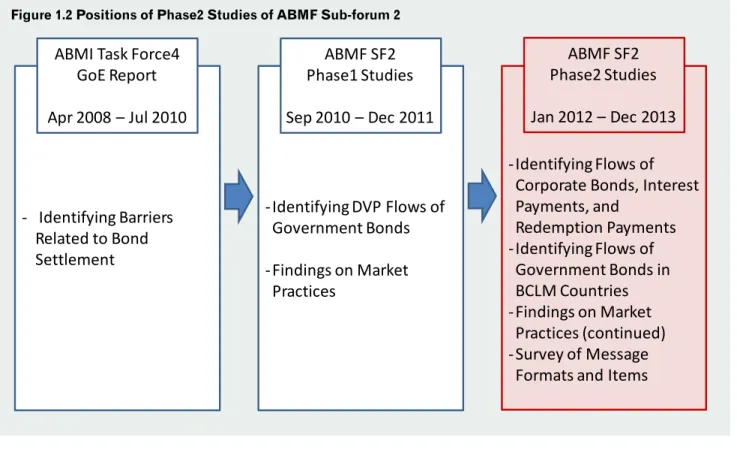
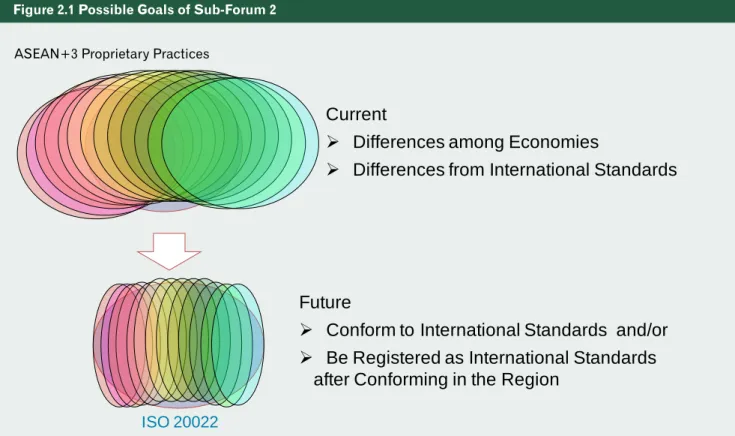
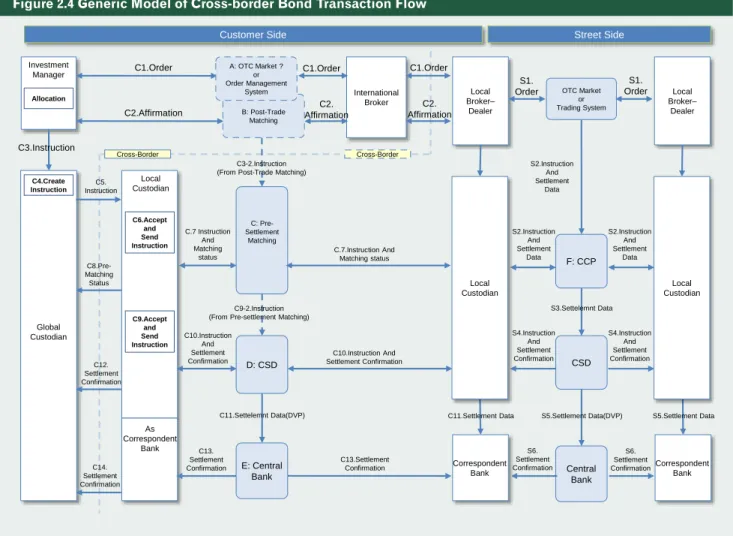
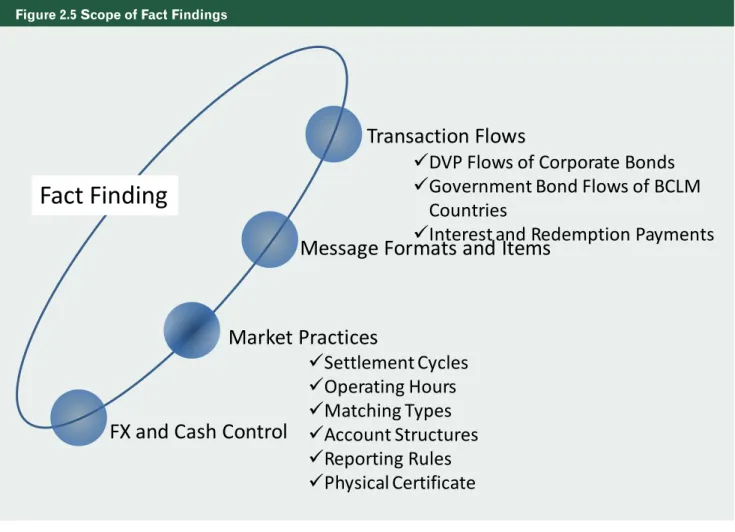
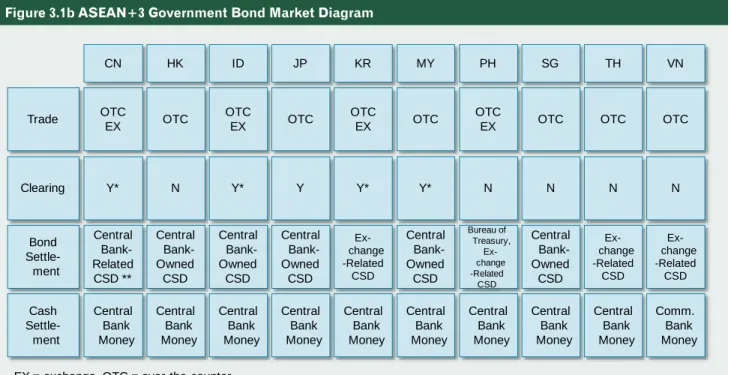
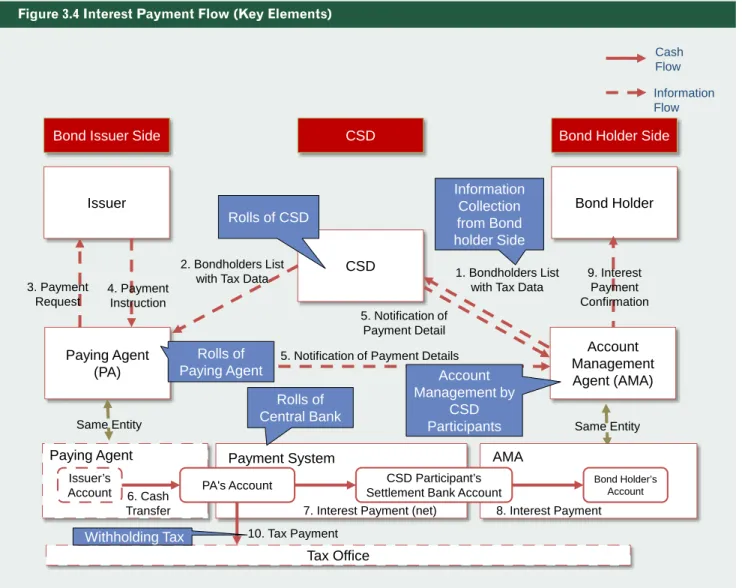
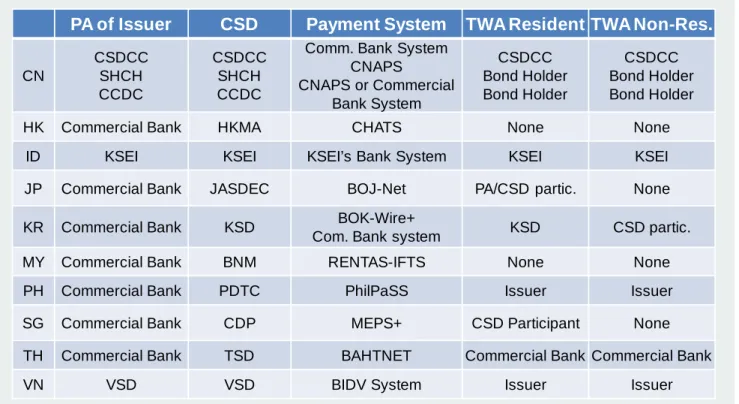
![Figure 3.5 ISO20022 Current world trend – Securities MI & Treasury MI DTCC, US JASDEC, JP [Post-trade]Euroclear Clearstream ANBIMA, BR T2S, EU CSD, LICSD, PL 27 CSD, EE CSD, LT ASX, AULiveLiveCLS Treasury MISecurities MISGX, SG JASDEC & TSE, JP[Co](https://thumb-ap.123doks.com/thumbv2/123deta/5780730.32474/41.918.106.839.139.633/current-securities-treasury-euroclear-clearstream-aulivelivecls-treasury-misecurities.webp)
